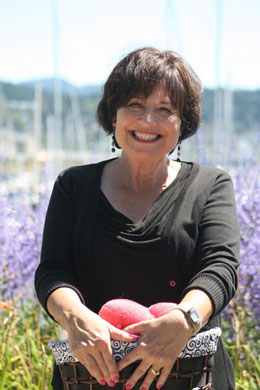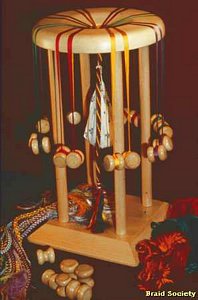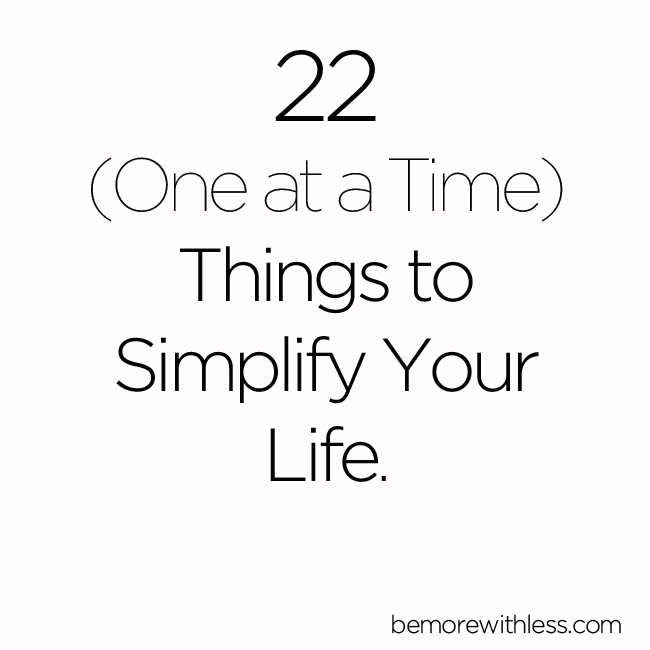Having been reminded just recently, albeit gently, that I haven't posted much on simplifying of late, the truth is that at times it seems a bit overwhelming. Life certainly has a way of getting complicated, complex, and "things" multiply quickly. So what wonderful timing to receive the following post from Courtney at bemorewithless.com!
There is an endless list of things to do to live more simply, be happier, and improve our lives. There is always more we could be doing. Just thinking about all of the things we can do is overwhelming.
I used to go for the do it all or die trying approach, but I usually ended up burning out and not doing anything very well. Once I started to focus on one thing at a time, I had more energy, attention, and commitment to see things through and discover the benefits.
Try one or more of these 22 ways to simplify your life, but only choose one at a time.
One
Project 333. A new season of minimalist fashion challenge Project 333 begins on October 1st. A simple closet is the gateway to a simple life. Once you experience the benefits of simplicity in your wardrobe, you’ll want it everywhere.
Two
Stop shopping for a while. You can’t shop your way out of the pain of the past, or shop your way into a secure future. Instead come back to right now. Do you have everything you need for today?
Three
Hide your stuff. If you have trouble letting go of something, hide it for 30 days first. If you don’t miss it, let it go.
FourEmbrace journaling. I write down at least three pages of thoughts and words a day. It helps me let go of the busyness in my mind. My good friend and author, Tammy Strobel is giving away a seat in her journaling class that starts in October.
Go get it.
Five
Change your routine. Experiment with a new routine. If you usually go into the office at 8am, try going in at 8:30 and take a walk before you get started. If you wake up and rush out the door, try waking up earlier to create a morning slow down. If you stay up late watching TV or engaging on social platforms, trade your screen time for a good book and a cup of tea.
SixInbox zen. If opening your inbox is more horrifying than opening your closet, take back your email with this
5-step guide to inbox zen.
Seven
Nap. Lay down, close your eyes, and rest for 30 minutes.
Eight
Create space for happiness. If you’ve been holding on to things that make you sad, like jeans that don’t fit, a gift from an x, or artifacts from a past life that don’t lift your heart, let them go. If they offer nothing but sadness, when you let go, you’ll make room for light and joy.
Ten
Start an emergency fund. If you are in debt, financial author Dave Ramsey suggests building an emergency fund of $1000. Once your debt is paid off, aim for a fund of 3-6 months of living expenses.
The emergency fund provides peace of mind knowing you won’t have to turn your life upside down when your car breaks down, you lose your job, or experience another financial set back.
Eleven
Call a timeout. When I call daily timeouts to go for a walk, make a special lunch, or engage in a creative non-work activity, I produce better work, and feel healthier and more energized. Think about where you need timeouts in your life. Timeouts prevent burn out.
Thirteen
Make something. Sometimes the best thing you can do to simplify your day is to make something. Write a poem, start a book, get out the finger paints and a big piece of paper, and express yourself. Make. Create. Enjoy the process with no expectations.
FourteenGo paperless. Shuffling stacks of paper is so 2005. Even when I stored paper in a filing cabinet, I never went back to it. Scan the stuff you need and let go of the rest. Try a service like
Shoeboxed to organize your receipts.
Fifteen
Clean out your car. Bring two small bags to your car. Fill one with trash and the other with anything that doesn’t belong in the car.
Sixteen
Give. Life gets complicated when we can’t stop thinking about ourselves; our needs, our struggles, our pain. If you are caught up in that, the quickest way to shift out is to give. Think about someone else. Ease their pain.
Seventeen
Nothing. Maybe the one thing you need to do first is nothing. If seeking is overshadowing your seeing, choose nothing today. Sometimes your soul needs time to just hang out with your heart, and your truth.
NineteenGo green. Unless I’m traveling, I try to drink a green smoothie every morning. My recipe includes some combination of kale, spinach, avocado, fennel, banana, chia seeds, berries and protein powder. For more inspiration and recipes with exact measurements, try the
30 day simple green smoothie challenge. Greens are essential for good health, and good health makes everything simpler.
Twenty
Get outside. Go for a walk, lay down in the park, or take a hike. I had a chance to walk through the falling Aspen leaves pictured above with my husband this weekend. Getting outside and connecting with nature helps to simplify and renew.
Twenty-one
Change your social environment. Start with your social networks. Who do you follow on Facebook, Instagram and other social streams. Do they share things that lift you up or things that make you feel bad about yourself? Do they share things that make you feel more connected to them or less? Unfriend, unfollow, and curate a social stream of love and support.
In your day-to-day life, surround yourself by people who lift you up, and lift them right back.
Twenty-twoCreate a simple year. Make simplicity the focus of an entire year. 2016 marks year #3 for the year-long simplicity program,
A Simple Year. Each year, we have new topics and contributors so you can dedicate each month to just one area of simplicity.
Next year, the topics will include clutter, busyness, travel, kitchen, digital, work, money, mindfulness, self-care, food, relationships, and gratitude.
Sign up here to be notified when early bird registration opens in a few weeks.
Some of these things may need a month of focus or more, and others just a few minutes. Choose the one thing that will best serve you.
Just developing the habit of only choosing one thing at a time will simplify your life. Leo’s
rules for single tasking will help too. Use the momentum from completing your one thing to fuel the next. Create a ripple effect of simplicity that turns into waves of space, time, ease, joy, and love.









